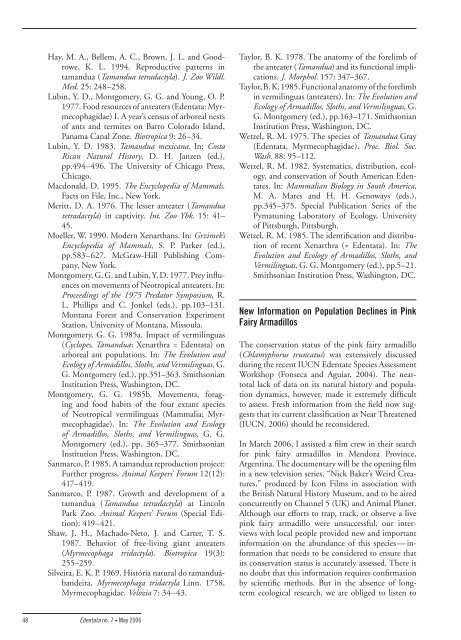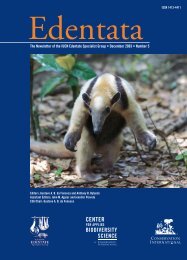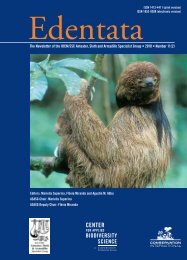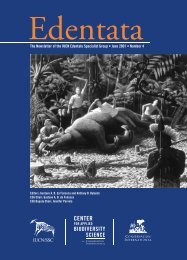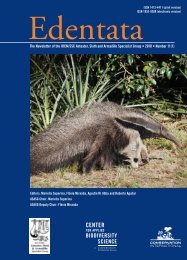Edentata 7 - Anteater, Sloth & Armadillo Specialist Group
Edentata 7 - Anteater, Sloth & Armadillo Specialist Group
Edentata 7 - Anteater, Sloth & Armadillo Specialist Group
- No tags were found...
You also want an ePaper? Increase the reach of your titles
YUMPU automatically turns print PDFs into web optimized ePapers that Google loves.
Hay, M. A., Bellem, A. C., Brown, J. L. and Goodrowe,<br />
K. L. 1994. Reproductive patterns in<br />
tamandua (Tamandua tetradactyla). J. Zoo Wildl.<br />
Med. 25: 248–258.<br />
Lubin, Y. D., Montgomery, G. G. and Young, O. P.<br />
1977. Food resources of anteaters (<strong>Edentata</strong>: Myrmecophagidae)<br />
I. A year’s census of arboreal nests<br />
of ants and termites on Barro Colorado Island,<br />
Panama Canal Zone. Biotropica 9: 26–34.<br />
Lubin, Y. D. 1983. Tamandua mexicana. In: Costa<br />
Rican Natural History, D. H. Janzen (ed.),<br />
pp.494–496. The University of Chicago Press,<br />
Chicago.<br />
Macdonald, D. 1995. The Encyclopedia of Mammals.<br />
Facts on File, Inc., New York.<br />
Meritt, D. A. 1976. The lesser anteater (Tamandua<br />
tetradactyla) in captivity. Int. Zoo Ybk. 15: 41–<br />
45.<br />
Moeller, W. 1990. Modern Xenarthans. In: Grzimek’s<br />
Encyclopedia of Mammals, S. P. Parker (ed.),<br />
pp.583–627. McGraw-Hill Publishing Company,<br />
New York.<br />
Montgomery, G. G. and Lubin, Y. D. 1977. Prey influences<br />
on movements of Neotropical anteaters. In:<br />
Proceedings of the 1975 Predator Symposium, R.<br />
L. Phillips and C. Jonkel (eds.), pp.103–131.<br />
Montana Forest and Conservation Experiment<br />
Station, University of Montana, Missoula.<br />
Montgomery, G. G. 1985a. Impact of vermilinguas<br />
(Cyclopes, Tamandua: Xenarthra = <strong>Edentata</strong>) on<br />
arboreal ant populations. In: The Evolution and<br />
Ecology of <strong>Armadillo</strong>s, <strong>Sloth</strong>s, and Vermilinguas, G.<br />
G. Montgomery (ed.), pp.351–363. Smithsonian<br />
Institution Press, Washington, DC.<br />
Montgomery, G. G. 1985b. Movements, foraging<br />
and food habits of the four extant species<br />
of Neotropical vermilinguas (Mammalia; Myrmecophagidae).<br />
In: The Evolution and Ecology<br />
of <strong>Armadillo</strong>s, <strong>Sloth</strong>s, and Vermilinguas, G. G.<br />
Montgomery (ed.), pp. 365–377. Smithsonian<br />
Institution Press, Washington, DC.<br />
Sanmarco, P. 1985. A tamandua reproduction project:<br />
Further progress. Animal Keepers’ Forum 12(12):<br />
417–419.<br />
Sanmarco, P. 1987. Growth and development of a<br />
tamandua (Tamandua tetradactyla) at Lincoln<br />
Park Zoo. Animal Keepers’ Forum (Special Edition):<br />
419–421.<br />
Shaw, J. H., Machado-Neto, J. and Carter, T. S.<br />
1987. Behavior of free-living giant anteaters<br />
(Myrmecophaga tridactyla). Biotropica 19(3):<br />
255–259.<br />
Silveira, E. K. P. 1969. História natural do tamanduábandeira,<br />
Myrmecophaga tridactyla Linn. 1758,<br />
Myrmecophagidae. Velozia 7: 34–43.<br />
Taylor, B. K. 1978. The anatomy of the forelimb of<br />
the anteater (Tamandua) and its functional implications.<br />
J. Morphol. 157: 347–367.<br />
Taylor, B. K. 1985. Functional anatomy of the forelimb<br />
in vermilinguas (anteaters). In: The Evolution and<br />
Ecology of <strong>Armadillo</strong>s, <strong>Sloth</strong>s, and Vermilinguas, G.<br />
G. Montgomery (ed.), pp.163–171. Smithsonian<br />
Institution Press, Washington, DC.<br />
Wetzel, R. M. 1975. The species of Tamandua Gray<br />
(<strong>Edentata</strong>, Myrmecophagidae). Proc. Biol. Soc.<br />
Wash. 88: 95–112.<br />
Wetzel, R. M. 1982. Systematics, distribution, ecology,<br />
and conservation of South American Edentates.<br />
In: Mammalian Biology in South America,<br />
M. A. Mares and H. H. Genoways (eds.),<br />
pp.345–375. Special Publication Series of the<br />
Pymatuning Laboratory of Ecology, University<br />
of Pittsburgh, Pittsburgh.<br />
Wetzel, R. M. 1985. The identification and distribution<br />
of recent Xenarthra (= <strong>Edentata</strong>). In: The<br />
Evolution and Ecology of <strong>Armadillo</strong>s, <strong>Sloth</strong>s, and<br />
Vermilinguas, G. G. Montgomery (ed.), pp.5–21.<br />
Smithsonian Institution Press, Washington, DC.<br />
New Information on Population Declines in Pink<br />
Fairy <strong>Armadillo</strong>s<br />
The conservation status of the pink fairy armadillo<br />
(Chlamyphorus truncatus) was extensively discussed<br />
during the recent IUCN Edentate Species Assessment<br />
Workshop (Fonseca and Aguiar, 2004). The neartotal<br />
lack of data on its natural history and population<br />
dynamics, however, made it extremely difficult<br />
to assess. Fresh information from the field now suggests<br />
that its current classification as Near Threatened<br />
(IUCN, 2006) should be reconsidered.<br />
In March 2006, I assisted a film crew in their search<br />
for pink fairy armadillos in Mendoza Province,<br />
Argentina. The documentary will be the opening film<br />
in a new television series, “Nick Baker’s Weird Creatures,”<br />
produced by Icon Films in association with<br />
the British Natural History Museum, and to be aired<br />
concurrently on Channel 5 (UK) and Animal Planet.<br />
Although our efforts to trap, track, or observe a live<br />
pink fairy armadillo were unsuccessful, our interviews<br />
with local people provided new and important<br />
information on the abundance of this species — information<br />
that needs to be considered to ensure that<br />
its conservation status is accurately assessed. There is<br />
no doubt that this information requires confirmation<br />
by scientific methods. But in the absence of longterm<br />
ecological research, we are obliged to listen to<br />
48<br />
<strong>Edentata</strong> no. 7 • May 2006


